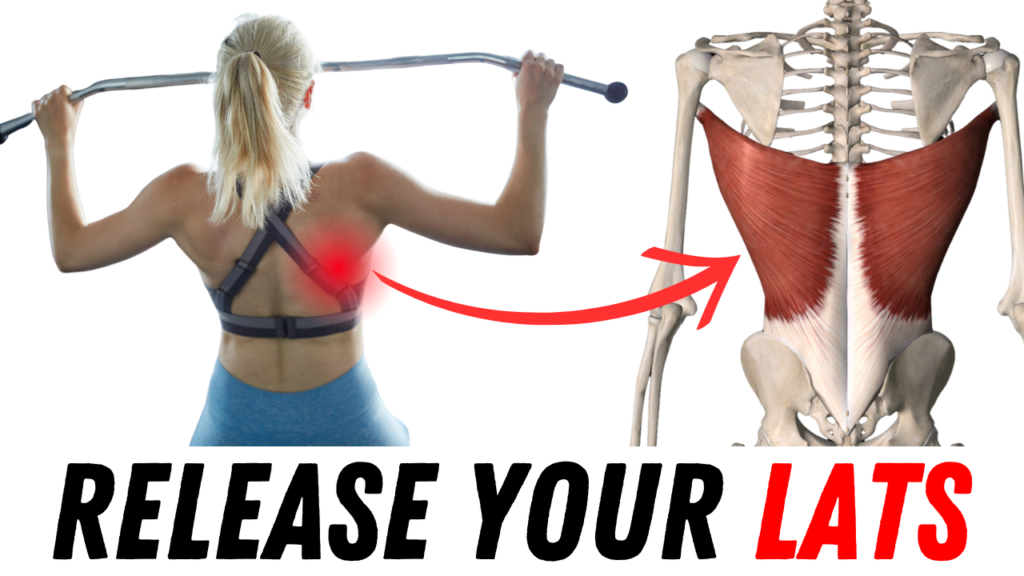
How to Release Tight Lat Muscles – Mobility Suite
- Dr. Mitch Israel
- Lower Back, Mobility, Movement & Pain, Stretching

How to Release Tight Lat Muscles: A Comprehensive Guide
Do you always have those tight lat muscles that make overhead movements a struggle or limit your shoulder mobility? If so, you’ve come to the right place. I’m Dr. Israel, a sports clinician who sees a lot of muscle and joint injuries. Tight lat muscles can contribute to shoulder injuries and act as potent lumbar extensors, potentially leading to lower back issues if chronically tight. In this guide, I’ll show you three sequential movements to help reduce tension, restore joint motion, and reinforce strength and stability in your latissimus dorsi muscles.
If you prefer videos, watch the video version below!
Understanding the Latissimus Dorsi
The latissimus dorsi, commonly referred to as the “lats,” is the largest muscle in the upper body. It extends from the lower back, through the thoracic region, and attaches to the humerus (upper arm bone). This muscle is responsible for several key movements, including shoulder adduction, extension, and internal rotation.
Due to its extensive reach and involvement in upper body movements, tightness in the lats can lead to a range of issues:
- Shoulder Pain: When the lats are tight, they restrict shoulder mobility, making it difficult to perform overhead movements. This limitation can cause compensatory patterns, leading to shoulder impingements, rotator cuff injuries, and general discomfort.
- Lower Back Pain: The lats attach to the lower back and play a role in stabilizing the lumbar spine. Chronic tightness can increase lumbar extension, leading to lower back strain and pain.
Why the Lats Become Tight
Understanding why the lats become tight is crucial for addressing the root cause of the issue. Here are some common reasons:
- Poor Posture: Prolonged sitting, especially with a rounded upper back, can shorten the lats and lead to chronic tightness.
- Overuse: Activities that involve repetitive pulling or overhead motions, such as weightlifting, swimming, or rock climbing, can overwork the lats and cause tightness.
- Imbalanced Training: Focusing too much on exercises that engage the lats without incorporating complementary stretches and mobility work can lead to imbalances and tightness.
- Lack of Stretching: Neglecting to stretch after workouts or in general can cause the lats to become stiff and inflexible over time.
- Stress and Tension: Emotional stress and physical tension can manifest in muscle tightness, including in the lats.
A Three-Step Approach to Releasing Tight Lats
To release tight lats for good, it’s essential to follow a comprehensive approach that addresses muscle tension, restores joint motion, and reinforces strength and stability. Here’s a detailed plan:
Step 1: Reduce Muscle Tension
To begin, we need to reduce the tension in the lat muscles. Here’s a simple yet effective stretch you can do using a squat rack, doorway, or door frame at home.
Stretch Using a Door Frame:
- Internal Rotation: Rotate your thumb downwards and hold onto the squat rack or door frame.
- Round Your Upper Back: Create expansion in your upper back and lean away until you feel a stretch in your lat.
- Rotate Opposite Shoulder: If stretching the left side, rotate your right shoulder towards your left hand to further elongate the muscle.
- Breathe Deeply: Breathe in through your nose and out through your mouth, sinking further into the stretch with each exhale. Aim for 10 to 15 breaths.
This stretch helps to elongate the lat muscle, relieving tension and preparing it for the subsequent steps.
Step 2: Restore Joint Motion
Once tension is reduced, it’s crucial to restore the joint motion in the shoulders to maintain the newfound flexibility.
Prone Swimmers:
- Starting Position: Lie face down with your hands on your lower back.
- Lift and Swim: Lift your hands and elbows off your back, moving them around to the top of your head as if swimming.
- Reverse Movement: Bring your hands back to the starting position.
- Reps: Aim for 10 to 15 slow, controlled repetitions.
Prone swimmers are excellent for restoring shoulder range of motion, especially by elongating the lats overhead.
Step 3: Reinforce with Strength and Stability
The final step is to reinforce the changes with strength and stability exercises to ensure long-term results.
Overhead Arm Raises:
- Starting Position: Lie on your back with knees bent and a flat, neutral spine.
- Raise Arms: Bring your arms overhead, trying to touch your thumbs to the ground without compromising your rib cage or spine alignment.
- Reps: Perform 10 to 15 reps, going further with each repetition.
This exercise not only helps in elongating the lats but also strengthens them, ensuring that the muscle can maintain its new length and flexibility.
Conclusion
There you have it! A comprehensive routine to relieve tight lat muscles and improve shoulder mobility. By reducing tension, restoring joint motion, and reinforcing with strength and stability, you’ll be on your way to better overhead movements and less discomfort.
Tight lat muscles can significantly impact both your shoulder and lower back health. Addressing this tightness with targeted exercises is crucial for maintaining overall upper body function and preventing pain.
Stay consistent with these movements, and you’ll see improvement over time. Happy stretching!
Remember, always consult a medical professional before trying new exercises if you experience pain.
Need a consistent plan for Mobility Training?
Do you know you need to train your mobility, but you don’t know where to start? Don’t worry, I have you covered! That is exactly why I created the Mobility Suite App so you can start mobility training for a fraction of the price of seeing a physical therapist and/or chiropractor!
I’ve created a library of mobility training programs (from hip mobility to spinal mobility) that you can have on-demand access to. These programs were carefully crafted to help you get the most out of mobility training with only minutes of work per training session! Less is more with mobility training. The most important thing is consistency! So, if you need a consistent strategy, start your FREE 7-day trial to my Mobility Suite App!
Why offer a 7-day free trial? I firmly adhere to the “1-week rule.” If you commit to consistent mobility training for one week, you’ll gather enough data to determine if it’s right for you. I’m confident that these programs will benefit you, and I want to give you the chance to experience it firsthand, completely free for one week. This way, you can determine whether mobility training aligns with your goals and needs without any financial commitment!
You have nothing to lose but the stiffness in your joints. Don’t let discomfort hold you back any longer— tap/click the button below to join today and take the first step toward a more mobile and pain-free lifestyle!




